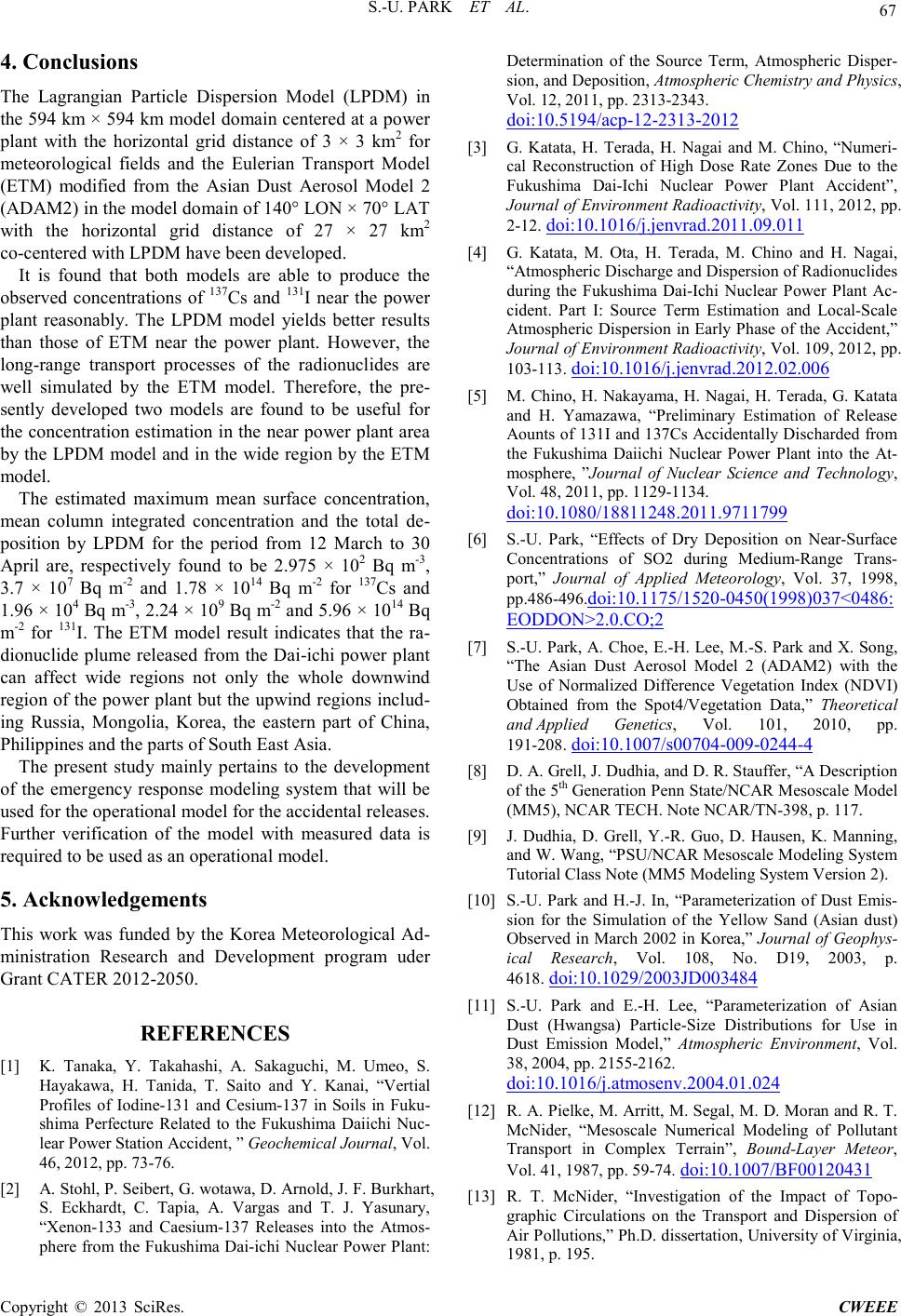
S.-U. PARK ET AL.
Copyright © 2013 SciRes. CWEEE
4. Conclusions
The Lagrangian Particle Dispersion Model (LPDM) in
the 594 km × 594 km model domain centered at a power
plant with the horizontal grid distance of 3 × 3 km2 for
meteorological fields and the Eulerian Transport Model
(ETM) modified from the Asian Dust Aerosol Model 2
(ADAM2) in the model domain of 140° LON × 70° LAT
with the horizontal grid distance of 27 × 27 km2
co-centered with LPDM have been developed.
It is found that both models are able to produce the
observed concentrations of 137Cs and 131I near the power
plant reasonably. The LPDM model yields better results
than those of ETM near the power plant. However, the
long-range transport processes of the radionuclides are
well simulated by the ETM model. Therefore, the pre-
sently developed two models are found to be useful for
the concentration estimation in the near power plant area
by the LP DM model and i n the wid e regi on by the ETM
model.
The estimated maximum mean surface concentration,
mean column integrated concentration and the total de-
position by LPDM for the period from 12 March to 30
April are, respectively found to be 2.975 × 102 Bq m-3,
3.7 × 107 Bq m-2 and 1.78 × 1014 Bq m-2 for 137Cs and
1.96 × 104 Bq m-3, 2.24 × 109 Bq m-2 and 5.96 × 1014 Bq
m-2 for 131I. The ETM model result indicates that the ra-
dionuclide plume released from the Dai-ichi power plant
can affect wide regions not only the whole downwind
regio n of the p ower p lant but the up wind reg ions incl ud-
ing Russia, Mongolia, Korea, the eastern part of China,
Philippines and the parts of South East Asia.
The present study mainly pertains to the development
of the emergency response modeling system that will be
used for the operational model for the accidental releases.
Further verification of the model with measured data is
required to be used as an operational model.
5. Acknowledgements
This work was funded by the Korea Meteorological Ad-
ministration Research and Development program uder
Grant CATER 2012-2050.
REFERENCES
[1] K. Tanaka, Y. Takahashi, A. Sakaguchi, M. Umeo, S.
Hayakawa, H. Tanida, T. Saito and Y. Kanai, “Vertial
Profiles of Iodine-131 and Cesium-137 in Soils in Fuku-
shima Perfecture Related to the Fukushima Daiichi Nuc-
lear Po wer Statio n Accident , ” Geochemical Journal, Vol.
46, 2012 , pp. 73-76.
[2] A. Stohl, P. Seibert, G. wotawa, D. Arnold, J. F. Burkhart,
S. Eckhardt, C. Tapia, A. Vargas and T. J. Yasunary,
“Xenon-133 and Caesium-137 Releases into the Atmos-
phere from the Fukushima Dai-ichi Nuclear Power Plant:
Determination of the Source Term, Atmospheric Disper-
sion, and Deposition, Atmospheric Chemistry and Physics,
Vol. 12, 2011, pp. 2313-2343.
doi:10.5194/acp-12-2313-2012
[3] G. Katata, H. Terada, H. Nagai and M. Chino, “Numer i-
cal Reconstruction of High Dose Rate Zones Due to the
Fukushima Dai-Ichi Nuclear Power Plant Accident”,
Journal of Environment Radioactivity, Vol. 111, 2012, pp.
2-12. doi:10.1016/j.jenvrad.2011.09.011
[4] G. Katata, M. Ota, H. Terada, M. Chino and H. Nagai,
“Atmospheric Dischar ge and Dispersion of Radionuclides
during the Fukushima Dai-Ichi Nuclear Power Plant Ac-
cident. Part I: Source Term Estimation and Local-Scale
Atmospheric Dispersion in Early Phase of the Accident,”
Journal of Environment Radioactivity, Vol. 109, 2012, pp.
103-113. doi:10.1016/j.jenvrad.2012.02.006
[5] M. Chino, H. Nakayama, H. Nagai, H. Terada, G. Katata
and H. Yamazawa, “Preliminary Estimation of Release
Aounts of 131I and 137Cs Accidentally Di scharded fro m
the Fukushima Daiichi Nuclear Power Plant into the At-
mosphere, ”Journal of Nuclear Science and Technology,
Vol. 48, 2011, pp. 1129-1134.
doi:10.1080/18811248.2011.9711799
[6] S.-U. Park, “Effects of Dry Deposition on Near-Surface
Concentrations of SO2 during Medium-Range Trans-
port,” Journal of Applied Meteorology, Vol. 37, 1998,
pp.486-496.doi:10.1175/1520-0450(1998)037<0486:
EODDON>2.0.CO;2
[7] S.-U. Park, A. Choe, E.-H. Lee, M.-S . Park and X. Song,
“The Asian Dust Aerosol Model 2 (ADAM2) with the
Use of Normalized Difference Vegetation Index (NDVI)
Obtained from the Spot4/Vegetation Data,” Theoret ical
and Applied Genetics, Vol. 101, 2010, pp.
191-208. doi:10.1007/s00704-009-0244-4
[8] D. A. Grell, J. Dudhia, and D. R. Stauffer, “A Description
of the 5th Generati on P enn State/NC AR Mesoscale Model
(MM5), NCAR TECH. Note NCAR/TN-398, p. 117.
[9] J. Dudhia, D. Grell, Y.-R. Guo, D. Hausen, K. Manning,
and W. Wang, “PSU/NCAR Mesoscale Modeling System
Tutorial Class Note (MM5 Modeling System Version 2).
[10] S.-U. P ark and H.-J. In, “Par ameterization of Dust Emis-
sion for the Simulation of the Yellow Sand (Asian dust)
Observed in March 2002 in Korea,” Journal of Geophys-
ical R esearch, Vol. 108, No. D19, 2003, p.
4618. doi:10.1029/2003JD003484
[11] S.-U. Park and E.-H. Lee, “Parameterization of Asian
Dust (Hwangsa) Particle-Size Distributions for Use in
Dust Emission Model,” Atmospheric Environment, Vol.
38, 2004, pp. 2155-2162.
doi:10.1016/j.atmosenv.2004.01.024
[12] R. A. Pielke, M. Arritt, M. Segal, M. D. Moran and R. T.
McNider, “Mesoscale Numerical Modeling of Pollutant
Transport in Complex Terrain”, Bound-Layer Meteor,
Vol. 41, 1987, pp. 59-74. doi:10.1007/BF00120431
[13] R. T. McNider, “Investigation of the Impact of Topo-
graphic Circulations on the Transport and Dispersion of
Air Pollutions,” Ph.D. dissertation, University of Virginia,
1981, p. 195.